PUBH631: Infectious Disease Prevention in Tokyo Olympics Report
VerifiedAdded on 2022/09/18
|11
|3125
|36
Report
AI Summary
This report delves into the critical aspects of disease prevention and management in the context of the 2020 Summer Olympics in Tokyo. It begins by analyzing the environmental conditions conducive to the spread of infectious diseases, including factors like water supply, sanitation, climate, and overcrowding. The report then outlines the infrastructure necessary for effective infection control, emphasizing the importance of public health planning, waste management, and healthcare services. It identifies major infectious diseases of concern, such as vaccine-preventable diseases, influenza, tuberculosis, foodborne illnesses, and vector-borne diseases, along with their aetiology and epidemiology. The report also discusses critical control points for disease prevention, focusing on waste disposal, food preparation, and sanitation. Finally, it examines the role of transport access in affecting the risk of infectious disease transmission, highlighting the need for comprehensive public health measures to mitigate potential outbreaks during mass gatherings like the Olympics.
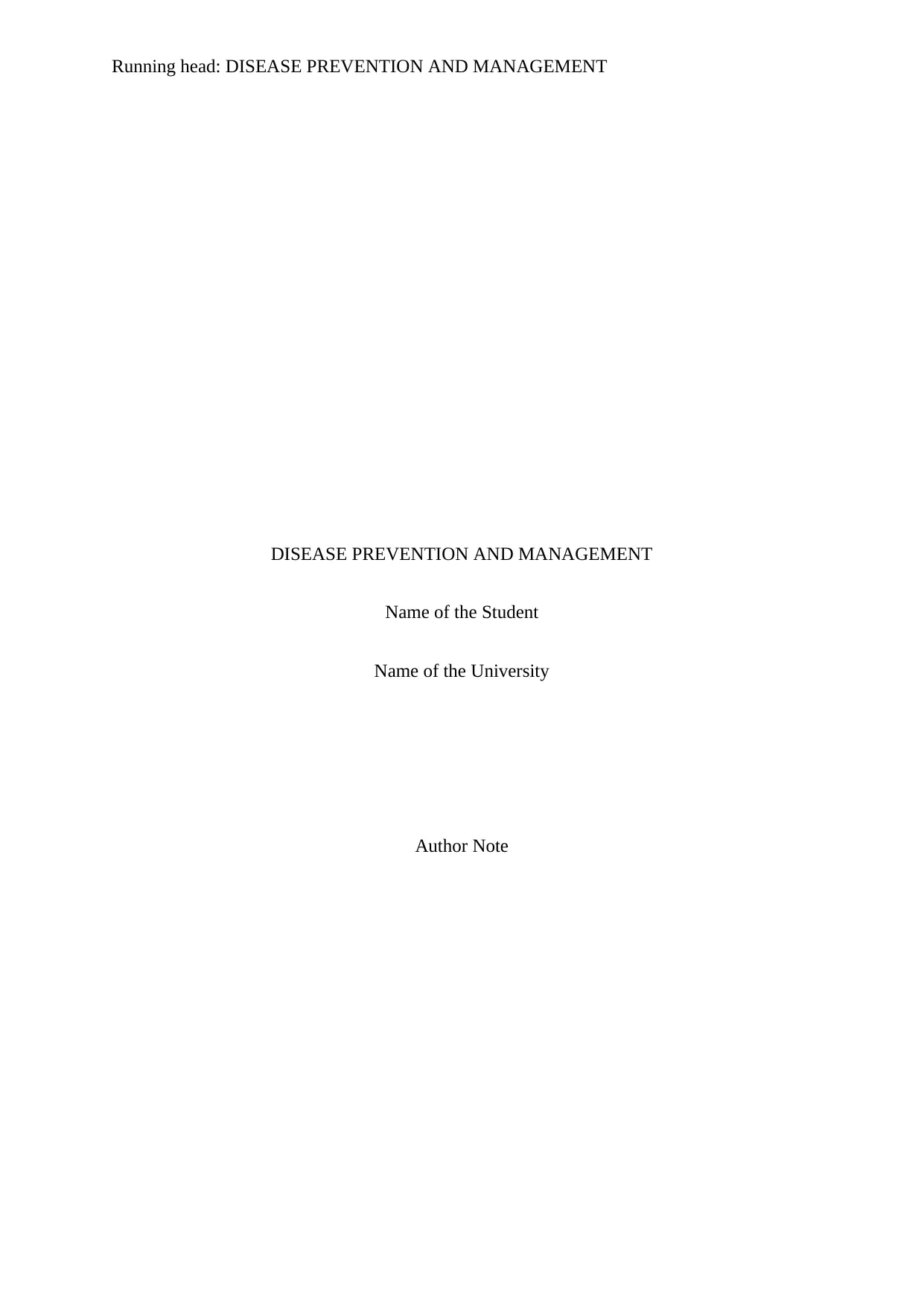
Running head: DISEASE PREVENTION AND MANAGEMENT
DISEASE PREVENTION AND MANAGEMENT
Name of the Student
Name of the University
Author Note
DISEASE PREVENTION AND MANAGEMENT
Name of the Student
Name of the University
Author Note
Paraphrase This Document
Need a fresh take? Get an instant paraphrase of this document with our AI Paraphraser
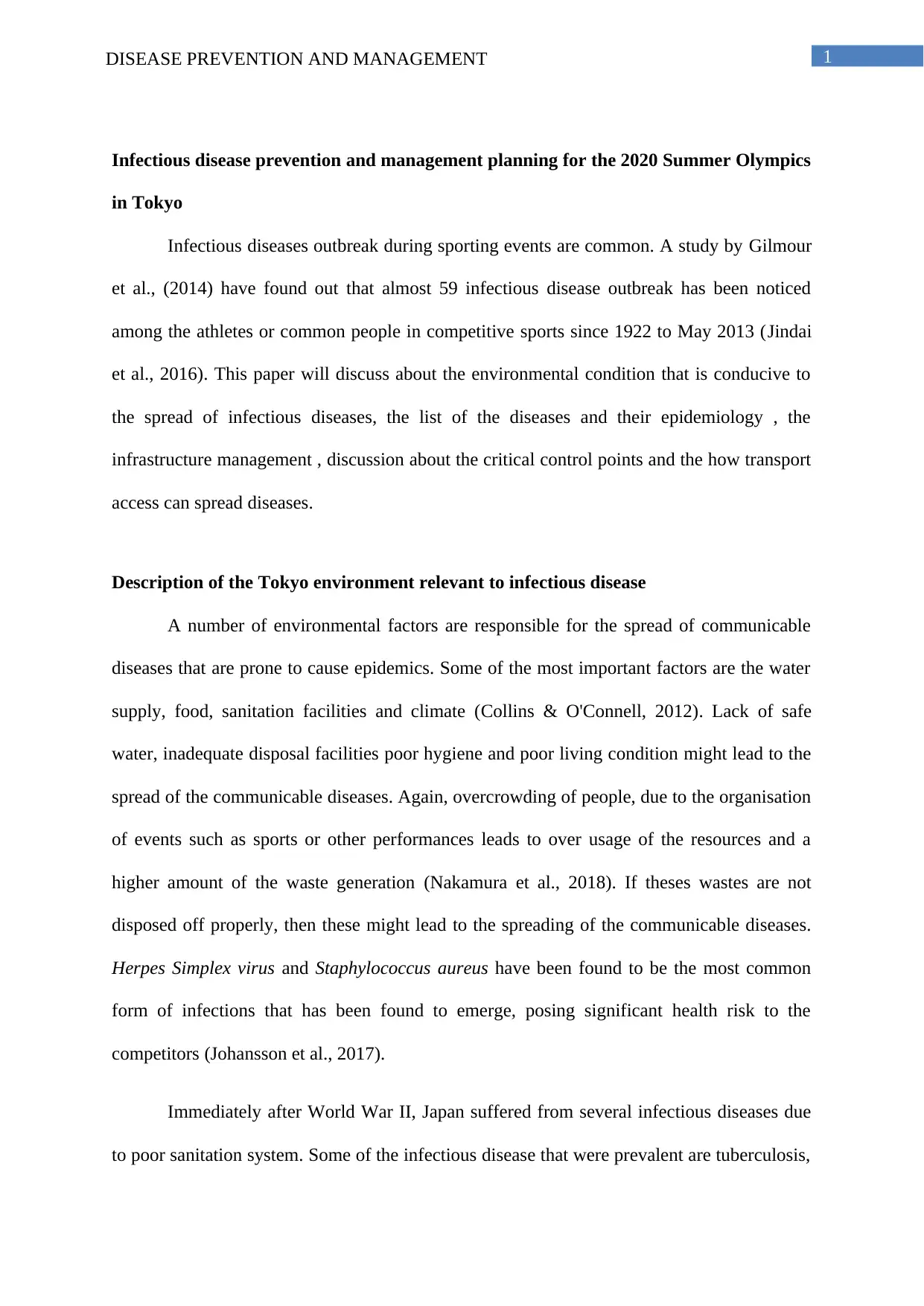
1DISEASE PREVENTION AND MANAGEMENT
Infectious disease prevention and management planning for the 2020 Summer Olympics
in Tokyo
Infectious diseases outbreak during sporting events are common. A study by Gilmour
et al., (2014) have found out that almost 59 infectious disease outbreak has been noticed
among the athletes or common people in competitive sports since 1922 to May 2013 (Jindai
et al., 2016). This paper will discuss about the environmental condition that is conducive to
the spread of infectious diseases, the list of the diseases and their epidemiology , the
infrastructure management , discussion about the critical control points and the how transport
access can spread diseases.
Description of the Tokyo environment relevant to infectious disease
A number of environmental factors are responsible for the spread of communicable
diseases that are prone to cause epidemics. Some of the most important factors are the water
supply, food, sanitation facilities and climate (Collins & O'Connell, 2012). Lack of safe
water, inadequate disposal facilities poor hygiene and poor living condition might lead to the
spread of the communicable diseases. Again, overcrowding of people, due to the organisation
of events such as sports or other performances leads to over usage of the resources and a
higher amount of the waste generation (Nakamura et al., 2018). If theses wastes are not
disposed off properly, then these might lead to the spreading of the communicable diseases.
Herpes Simplex virus and Staphylococcus aureus have been found to be the most common
form of infections that has been found to emerge, posing significant health risk to the
competitors (Johansson et al., 2017).
Immediately after World War II, Japan suffered from several infectious diseases due
to poor sanitation system. Some of the infectious disease that were prevalent are tuberculosis,
Infectious disease prevention and management planning for the 2020 Summer Olympics
in Tokyo
Infectious diseases outbreak during sporting events are common. A study by Gilmour
et al., (2014) have found out that almost 59 infectious disease outbreak has been noticed
among the athletes or common people in competitive sports since 1922 to May 2013 (Jindai
et al., 2016). This paper will discuss about the environmental condition that is conducive to
the spread of infectious diseases, the list of the diseases and their epidemiology , the
infrastructure management , discussion about the critical control points and the how transport
access can spread diseases.
Description of the Tokyo environment relevant to infectious disease
A number of environmental factors are responsible for the spread of communicable
diseases that are prone to cause epidemics. Some of the most important factors are the water
supply, food, sanitation facilities and climate (Collins & O'Connell, 2012). Lack of safe
water, inadequate disposal facilities poor hygiene and poor living condition might lead to the
spread of the communicable diseases. Again, overcrowding of people, due to the organisation
of events such as sports or other performances leads to over usage of the resources and a
higher amount of the waste generation (Nakamura et al., 2018). If theses wastes are not
disposed off properly, then these might lead to the spreading of the communicable diseases.
Herpes Simplex virus and Staphylococcus aureus have been found to be the most common
form of infections that has been found to emerge, posing significant health risk to the
competitors (Johansson et al., 2017).
Immediately after World War II, Japan suffered from several infectious diseases due
to poor sanitation system. Some of the infectious disease that were prevalent are tuberculosis,
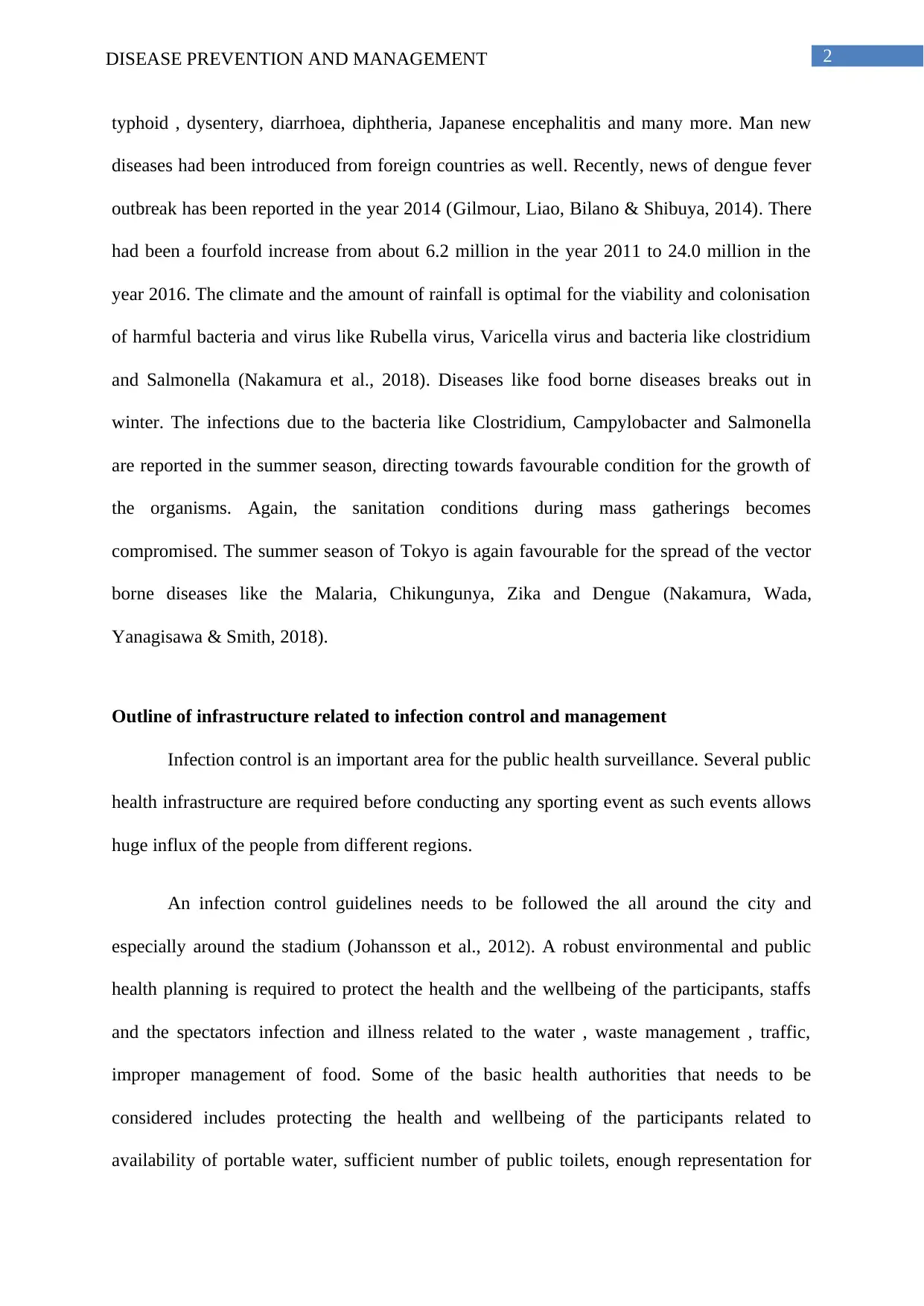
2DISEASE PREVENTION AND MANAGEMENT
typhoid , dysentery, diarrhoea, diphtheria, Japanese encephalitis and many more. Man new
diseases had been introduced from foreign countries as well. Recently, news of dengue fever
outbreak has been reported in the year 2014 (Gilmour, Liao, Bilano & Shibuya, 2014). There
had been a fourfold increase from about 6.2 million in the year 2011 to 24.0 million in the
year 2016. The climate and the amount of rainfall is optimal for the viability and colonisation
of harmful bacteria and virus like Rubella virus, Varicella virus and bacteria like clostridium
and Salmonella (Nakamura et al., 2018). Diseases like food borne diseases breaks out in
winter. The infections due to the bacteria like Clostridium, Campylobacter and Salmonella
are reported in the summer season, directing towards favourable condition for the growth of
the organisms. Again, the sanitation conditions during mass gatherings becomes
compromised. The summer season of Tokyo is again favourable for the spread of the vector
borne diseases like the Malaria, Chikungunya, Zika and Dengue (Nakamura, Wada,
Yanagisawa & Smith, 2018).
Outline of infrastructure related to infection control and management
Infection control is an important area for the public health surveillance. Several public
health infrastructure are required before conducting any sporting event as such events allows
huge influx of the people from different regions.
An infection control guidelines needs to be followed the all around the city and
especially around the stadium (Johansson et al., 2012). A robust environmental and public
health planning is required to protect the health and the wellbeing of the participants, staffs
and the spectators infection and illness related to the water , waste management , traffic,
improper management of food. Some of the basic health authorities that needs to be
considered includes protecting the health and wellbeing of the participants related to
availability of portable water, sufficient number of public toilets, enough representation for
typhoid , dysentery, diarrhoea, diphtheria, Japanese encephalitis and many more. Man new
diseases had been introduced from foreign countries as well. Recently, news of dengue fever
outbreak has been reported in the year 2014 (Gilmour, Liao, Bilano & Shibuya, 2014). There
had been a fourfold increase from about 6.2 million in the year 2011 to 24.0 million in the
year 2016. The climate and the amount of rainfall is optimal for the viability and colonisation
of harmful bacteria and virus like Rubella virus, Varicella virus and bacteria like clostridium
and Salmonella (Nakamura et al., 2018). Diseases like food borne diseases breaks out in
winter. The infections due to the bacteria like Clostridium, Campylobacter and Salmonella
are reported in the summer season, directing towards favourable condition for the growth of
the organisms. Again, the sanitation conditions during mass gatherings becomes
compromised. The summer season of Tokyo is again favourable for the spread of the vector
borne diseases like the Malaria, Chikungunya, Zika and Dengue (Nakamura, Wada,
Yanagisawa & Smith, 2018).
Outline of infrastructure related to infection control and management
Infection control is an important area for the public health surveillance. Several public
health infrastructure are required before conducting any sporting event as such events allows
huge influx of the people from different regions.
An infection control guidelines needs to be followed the all around the city and
especially around the stadium (Johansson et al., 2012). A robust environmental and public
health planning is required to protect the health and the wellbeing of the participants, staffs
and the spectators infection and illness related to the water , waste management , traffic,
improper management of food. Some of the basic health authorities that needs to be
considered includes protecting the health and wellbeing of the participants related to
availability of portable water, sufficient number of public toilets, enough representation for
⊘ This is a preview!⊘
Do you want full access?
Subscribe today to unlock all pages.

Trusted by 1+ million students worldwide
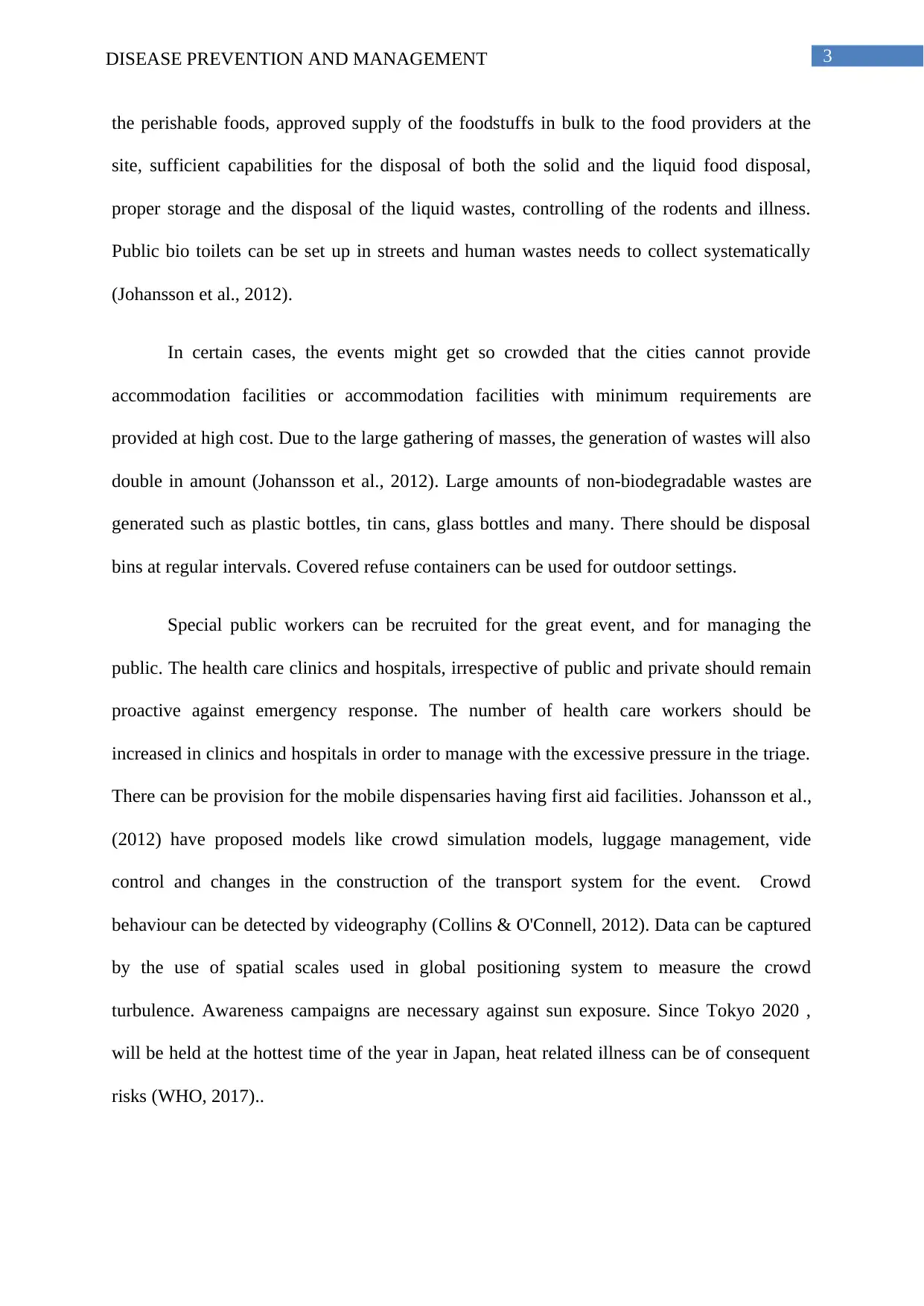
3DISEASE PREVENTION AND MANAGEMENT
the perishable foods, approved supply of the foodstuffs in bulk to the food providers at the
site, sufficient capabilities for the disposal of both the solid and the liquid food disposal,
proper storage and the disposal of the liquid wastes, controlling of the rodents and illness.
Public bio toilets can be set up in streets and human wastes needs to collect systematically
(Johansson et al., 2012).
In certain cases, the events might get so crowded that the cities cannot provide
accommodation facilities or accommodation facilities with minimum requirements are
provided at high cost. Due to the large gathering of masses, the generation of wastes will also
double in amount (Johansson et al., 2012). Large amounts of non-biodegradable wastes are
generated such as plastic bottles, tin cans, glass bottles and many. There should be disposal
bins at regular intervals. Covered refuse containers can be used for outdoor settings.
Special public workers can be recruited for the great event, and for managing the
public. The health care clinics and hospitals, irrespective of public and private should remain
proactive against emergency response. The number of health care workers should be
increased in clinics and hospitals in order to manage with the excessive pressure in the triage.
There can be provision for the mobile dispensaries having first aid facilities. Johansson et al.,
(2012) have proposed models like crowd simulation models, luggage management, vide
control and changes in the construction of the transport system for the event. Crowd
behaviour can be detected by videography (Collins & O'Connell, 2012). Data can be captured
by the use of spatial scales used in global positioning system to measure the crowd
turbulence. Awareness campaigns are necessary against sun exposure. Since Tokyo 2020 ,
will be held at the hottest time of the year in Japan, heat related illness can be of consequent
risks (WHO, 2017)..
the perishable foods, approved supply of the foodstuffs in bulk to the food providers at the
site, sufficient capabilities for the disposal of both the solid and the liquid food disposal,
proper storage and the disposal of the liquid wastes, controlling of the rodents and illness.
Public bio toilets can be set up in streets and human wastes needs to collect systematically
(Johansson et al., 2012).
In certain cases, the events might get so crowded that the cities cannot provide
accommodation facilities or accommodation facilities with minimum requirements are
provided at high cost. Due to the large gathering of masses, the generation of wastes will also
double in amount (Johansson et al., 2012). Large amounts of non-biodegradable wastes are
generated such as plastic bottles, tin cans, glass bottles and many. There should be disposal
bins at regular intervals. Covered refuse containers can be used for outdoor settings.
Special public workers can be recruited for the great event, and for managing the
public. The health care clinics and hospitals, irrespective of public and private should remain
proactive against emergency response. The number of health care workers should be
increased in clinics and hospitals in order to manage with the excessive pressure in the triage.
There can be provision for the mobile dispensaries having first aid facilities. Johansson et al.,
(2012) have proposed models like crowd simulation models, luggage management, vide
control and changes in the construction of the transport system for the event. Crowd
behaviour can be detected by videography (Collins & O'Connell, 2012). Data can be captured
by the use of spatial scales used in global positioning system to measure the crowd
turbulence. Awareness campaigns are necessary against sun exposure. Since Tokyo 2020 ,
will be held at the hottest time of the year in Japan, heat related illness can be of consequent
risks (WHO, 2017)..
Paraphrase This Document
Need a fresh take? Get an instant paraphrase of this document with our AI Paraphraser
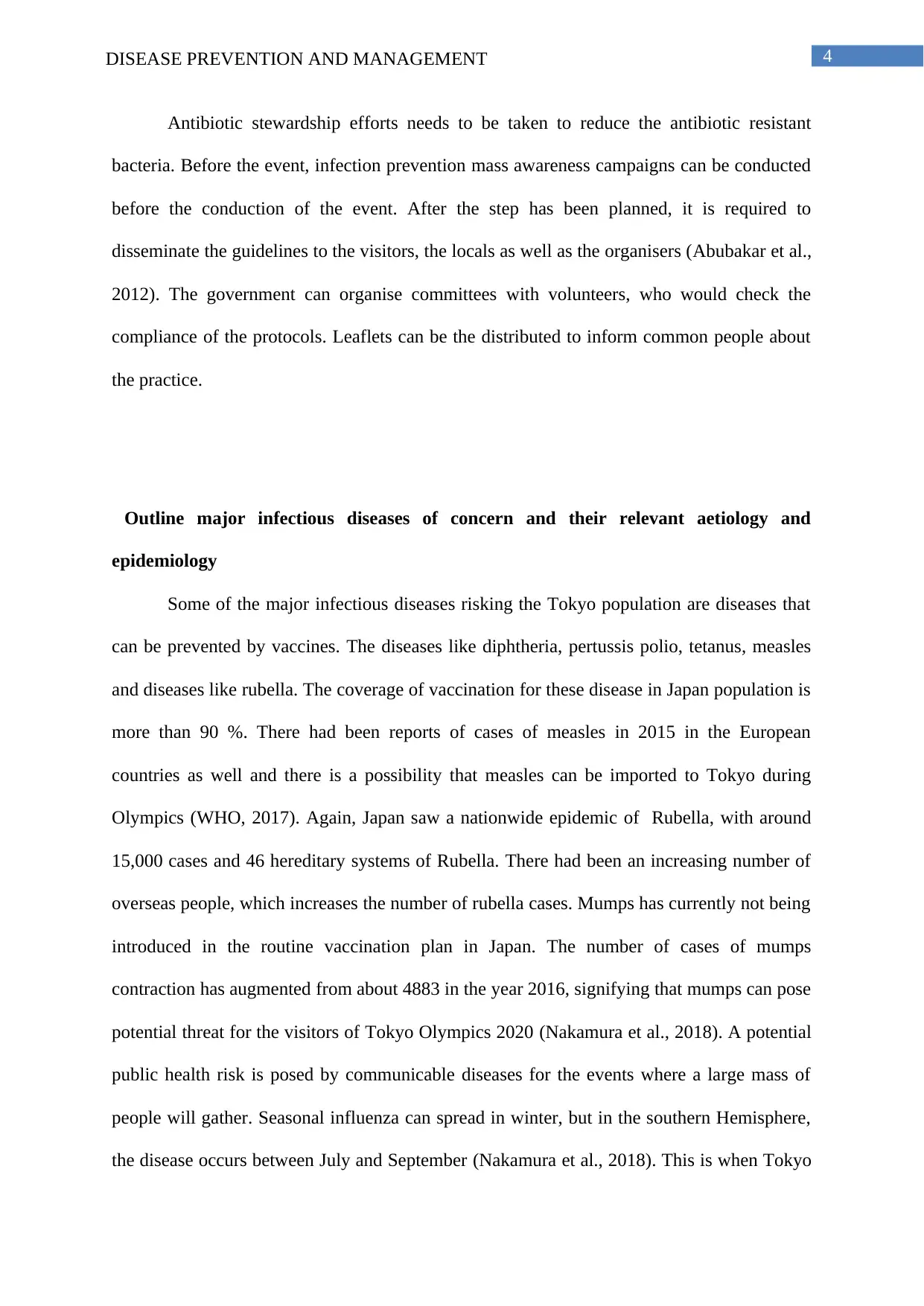
4DISEASE PREVENTION AND MANAGEMENT
Antibiotic stewardship efforts needs to be taken to reduce the antibiotic resistant
bacteria. Before the event, infection prevention mass awareness campaigns can be conducted
before the conduction of the event. After the step has been planned, it is required to
disseminate the guidelines to the visitors, the locals as well as the organisers (Abubakar et al.,
2012). The government can organise committees with volunteers, who would check the
compliance of the protocols. Leaflets can be the distributed to inform common people about
the practice.
Outline major infectious diseases of concern and their relevant aetiology and
epidemiology
Some of the major infectious diseases risking the Tokyo population are diseases that
can be prevented by vaccines. The diseases like diphtheria, pertussis polio, tetanus, measles
and diseases like rubella. The coverage of vaccination for these disease in Japan population is
more than 90 %. There had been reports of cases of measles in 2015 in the European
countries as well and there is a possibility that measles can be imported to Tokyo during
Olympics (WHO, 2017). Again, Japan saw a nationwide epidemic of Rubella, with around
15,000 cases and 46 hereditary systems of Rubella. There had been an increasing number of
overseas people, which increases the number of rubella cases. Mumps has currently not being
introduced in the routine vaccination plan in Japan. The number of cases of mumps
contraction has augmented from about 4883 in the year 2016, signifying that mumps can pose
potential threat for the visitors of Tokyo Olympics 2020 (Nakamura et al., 2018). A potential
public health risk is posed by communicable diseases for the events where a large mass of
people will gather. Seasonal influenza can spread in winter, but in the southern Hemisphere,
the disease occurs between July and September (Nakamura et al., 2018). This is when Tokyo
Antibiotic stewardship efforts needs to be taken to reduce the antibiotic resistant
bacteria. Before the event, infection prevention mass awareness campaigns can be conducted
before the conduction of the event. After the step has been planned, it is required to
disseminate the guidelines to the visitors, the locals as well as the organisers (Abubakar et al.,
2012). The government can organise committees with volunteers, who would check the
compliance of the protocols. Leaflets can be the distributed to inform common people about
the practice.
Outline major infectious diseases of concern and their relevant aetiology and
epidemiology
Some of the major infectious diseases risking the Tokyo population are diseases that
can be prevented by vaccines. The diseases like diphtheria, pertussis polio, tetanus, measles
and diseases like rubella. The coverage of vaccination for these disease in Japan population is
more than 90 %. There had been reports of cases of measles in 2015 in the European
countries as well and there is a possibility that measles can be imported to Tokyo during
Olympics (WHO, 2017). Again, Japan saw a nationwide epidemic of Rubella, with around
15,000 cases and 46 hereditary systems of Rubella. There had been an increasing number of
overseas people, which increases the number of rubella cases. Mumps has currently not being
introduced in the routine vaccination plan in Japan. The number of cases of mumps
contraction has augmented from about 4883 in the year 2016, signifying that mumps can pose
potential threat for the visitors of Tokyo Olympics 2020 (Nakamura et al., 2018). A potential
public health risk is posed by communicable diseases for the events where a large mass of
people will gather. Seasonal influenza can spread in winter, but in the southern Hemisphere,
the disease occurs between July and September (Nakamura et al., 2018). This is when Tokyo
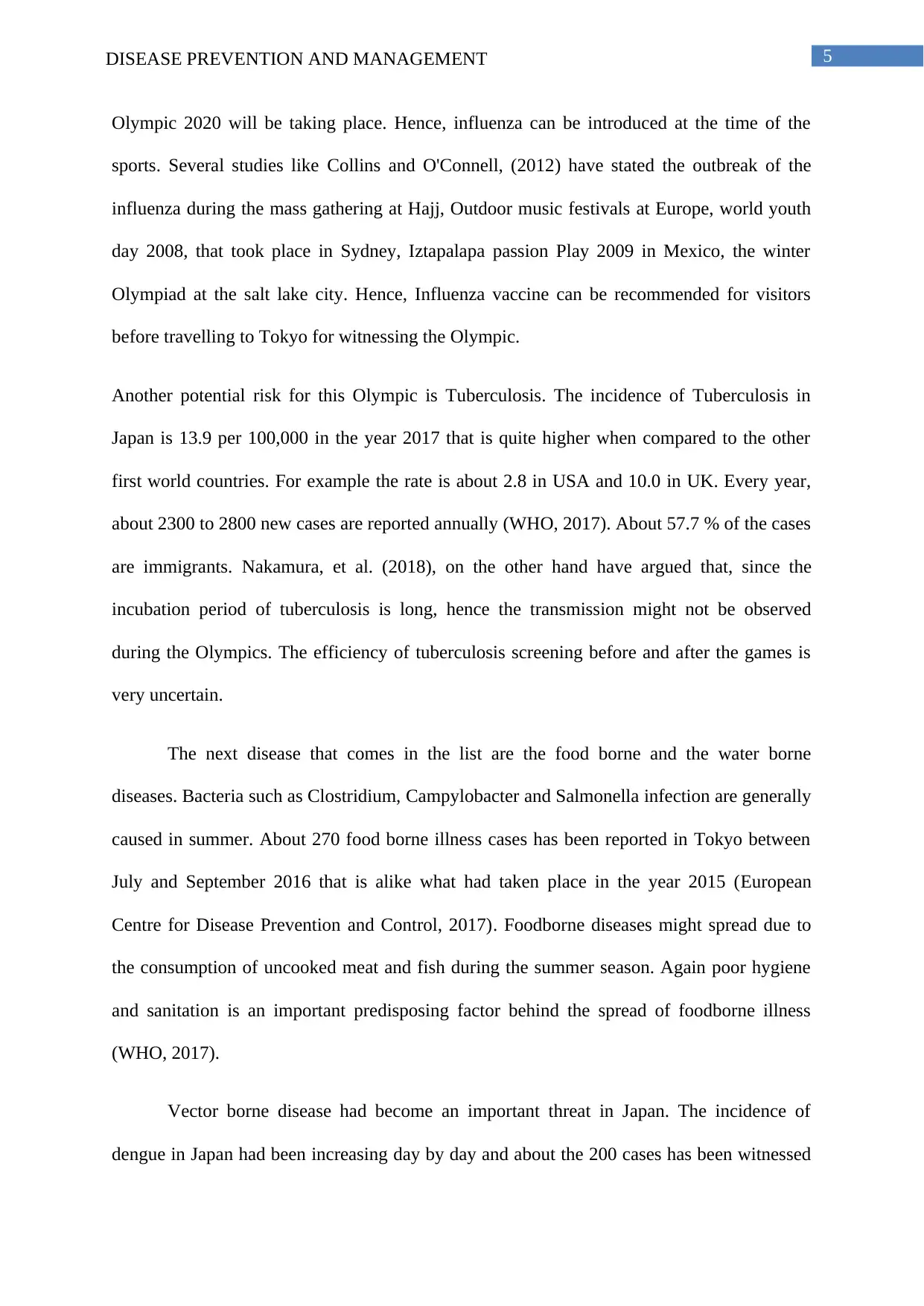
5DISEASE PREVENTION AND MANAGEMENT
Olympic 2020 will be taking place. Hence, influenza can be introduced at the time of the
sports. Several studies like Collins and O'Connell, (2012) have stated the outbreak of the
influenza during the mass gathering at Hajj, Outdoor music festivals at Europe, world youth
day 2008, that took place in Sydney, Iztapalapa passion Play 2009 in Mexico, the winter
Olympiad at the salt lake city. Hence, Influenza vaccine can be recommended for visitors
before travelling to Tokyo for witnessing the Olympic.
Another potential risk for this Olympic is Tuberculosis. The incidence of Tuberculosis in
Japan is 13.9 per 100,000 in the year 2017 that is quite higher when compared to the other
first world countries. For example the rate is about 2.8 in USA and 10.0 in UK. Every year,
about 2300 to 2800 new cases are reported annually (WHO, 2017). About 57.7 % of the cases
are immigrants. Nakamura, et al. (2018), on the other hand have argued that, since the
incubation period of tuberculosis is long, hence the transmission might not be observed
during the Olympics. The efficiency of tuberculosis screening before and after the games is
very uncertain.
The next disease that comes in the list are the food borne and the water borne
diseases. Bacteria such as Clostridium, Campylobacter and Salmonella infection are generally
caused in summer. About 270 food borne illness cases has been reported in Tokyo between
July and September 2016 that is alike what had taken place in the year 2015 (European
Centre for Disease Prevention and Control, 2017). Foodborne diseases might spread due to
the consumption of uncooked meat and fish during the summer season. Again poor hygiene
and sanitation is an important predisposing factor behind the spread of foodborne illness
(WHO, 2017).
Vector borne disease had become an important threat in Japan. The incidence of
dengue in Japan had been increasing day by day and about the 200 cases has been witnessed
Olympic 2020 will be taking place. Hence, influenza can be introduced at the time of the
sports. Several studies like Collins and O'Connell, (2012) have stated the outbreak of the
influenza during the mass gathering at Hajj, Outdoor music festivals at Europe, world youth
day 2008, that took place in Sydney, Iztapalapa passion Play 2009 in Mexico, the winter
Olympiad at the salt lake city. Hence, Influenza vaccine can be recommended for visitors
before travelling to Tokyo for witnessing the Olympic.
Another potential risk for this Olympic is Tuberculosis. The incidence of Tuberculosis in
Japan is 13.9 per 100,000 in the year 2017 that is quite higher when compared to the other
first world countries. For example the rate is about 2.8 in USA and 10.0 in UK. Every year,
about 2300 to 2800 new cases are reported annually (WHO, 2017). About 57.7 % of the cases
are immigrants. Nakamura, et al. (2018), on the other hand have argued that, since the
incubation period of tuberculosis is long, hence the transmission might not be observed
during the Olympics. The efficiency of tuberculosis screening before and after the games is
very uncertain.
The next disease that comes in the list are the food borne and the water borne
diseases. Bacteria such as Clostridium, Campylobacter and Salmonella infection are generally
caused in summer. About 270 food borne illness cases has been reported in Tokyo between
July and September 2016 that is alike what had taken place in the year 2015 (European
Centre for Disease Prevention and Control, 2017). Foodborne diseases might spread due to
the consumption of uncooked meat and fish during the summer season. Again poor hygiene
and sanitation is an important predisposing factor behind the spread of foodborne illness
(WHO, 2017).
Vector borne disease had become an important threat in Japan. The incidence of
dengue in Japan had been increasing day by day and about the 200 cases has been witnessed
⊘ This is a preview!⊘
Do you want full access?
Subscribe today to unlock all pages.

Trusted by 1+ million students worldwide
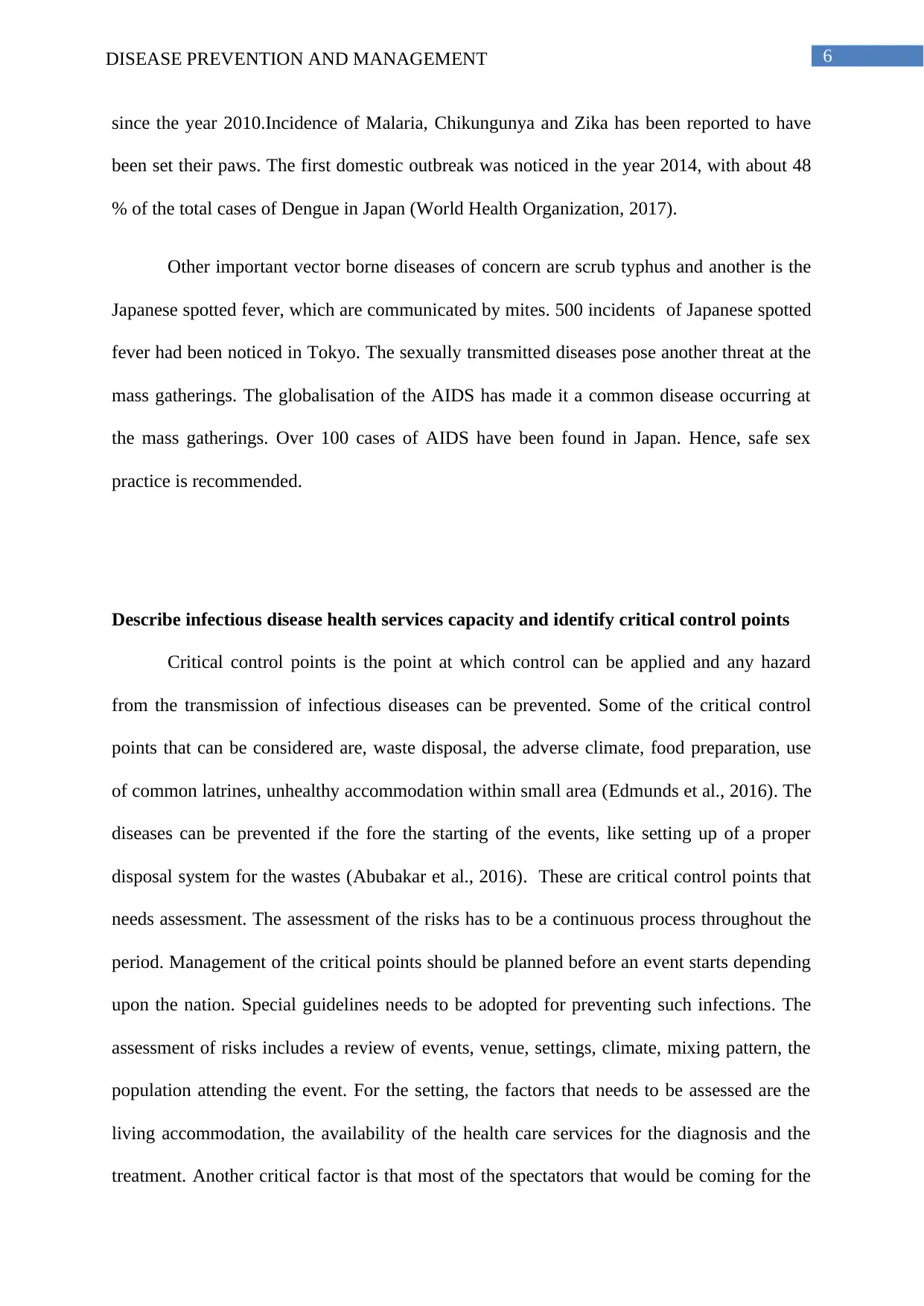
6DISEASE PREVENTION AND MANAGEMENT
since the year 2010.Incidence of Malaria, Chikungunya and Zika has been reported to have
been set their paws. The first domestic outbreak was noticed in the year 2014, with about 48
% of the total cases of Dengue in Japan (World Health Organization, 2017).
Other important vector borne diseases of concern are scrub typhus and another is the
Japanese spotted fever, which are communicated by mites. 500 incidents of Japanese spotted
fever had been noticed in Tokyo. The sexually transmitted diseases pose another threat at the
mass gatherings. The globalisation of the AIDS has made it a common disease occurring at
the mass gatherings. Over 100 cases of AIDS have been found in Japan. Hence, safe sex
practice is recommended.
Describe infectious disease health services capacity and identify critical control points
Critical control points is the point at which control can be applied and any hazard
from the transmission of infectious diseases can be prevented. Some of the critical control
points that can be considered are, waste disposal, the adverse climate, food preparation, use
of common latrines, unhealthy accommodation within small area (Edmunds et al., 2016). The
diseases can be prevented if the fore the starting of the events, like setting up of a proper
disposal system for the wastes (Abubakar et al., 2016). These are critical control points that
needs assessment. The assessment of the risks has to be a continuous process throughout the
period. Management of the critical points should be planned before an event starts depending
upon the nation. Special guidelines needs to be adopted for preventing such infections. The
assessment of risks includes a review of events, venue, settings, climate, mixing pattern, the
population attending the event. For the setting, the factors that needs to be assessed are the
living accommodation, the availability of the health care services for the diagnosis and the
treatment. Another critical factor is that most of the spectators that would be coming for the
since the year 2010.Incidence of Malaria, Chikungunya and Zika has been reported to have
been set their paws. The first domestic outbreak was noticed in the year 2014, with about 48
% of the total cases of Dengue in Japan (World Health Organization, 2017).
Other important vector borne diseases of concern are scrub typhus and another is the
Japanese spotted fever, which are communicated by mites. 500 incidents of Japanese spotted
fever had been noticed in Tokyo. The sexually transmitted diseases pose another threat at the
mass gatherings. The globalisation of the AIDS has made it a common disease occurring at
the mass gatherings. Over 100 cases of AIDS have been found in Japan. Hence, safe sex
practice is recommended.
Describe infectious disease health services capacity and identify critical control points
Critical control points is the point at which control can be applied and any hazard
from the transmission of infectious diseases can be prevented. Some of the critical control
points that can be considered are, waste disposal, the adverse climate, food preparation, use
of common latrines, unhealthy accommodation within small area (Edmunds et al., 2016). The
diseases can be prevented if the fore the starting of the events, like setting up of a proper
disposal system for the wastes (Abubakar et al., 2016). These are critical control points that
needs assessment. The assessment of the risks has to be a continuous process throughout the
period. Management of the critical points should be planned before an event starts depending
upon the nation. Special guidelines needs to be adopted for preventing such infections. The
assessment of risks includes a review of events, venue, settings, climate, mixing pattern, the
population attending the event. For the setting, the factors that needs to be assessed are the
living accommodation, the availability of the health care services for the diagnosis and the
treatment. Another critical factor is that most of the spectators that would be coming for the
Paraphrase This Document
Need a fresh take? Get an instant paraphrase of this document with our AI Paraphraser
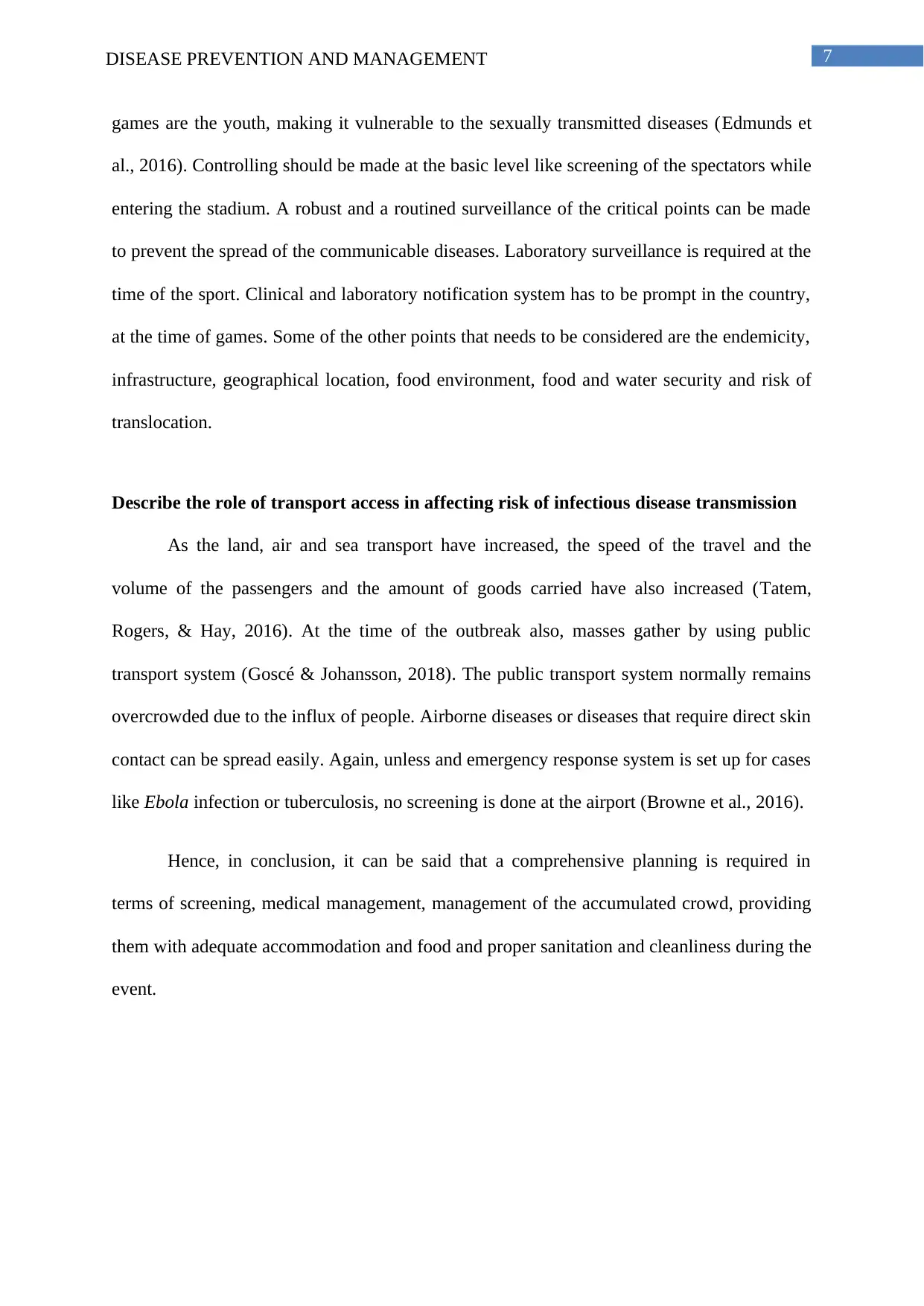
7DISEASE PREVENTION AND MANAGEMENT
games are the youth, making it vulnerable to the sexually transmitted diseases (Edmunds et
al., 2016). Controlling should be made at the basic level like screening of the spectators while
entering the stadium. A robust and a routined surveillance of the critical points can be made
to prevent the spread of the communicable diseases. Laboratory surveillance is required at the
time of the sport. Clinical and laboratory notification system has to be prompt in the country,
at the time of games. Some of the other points that needs to be considered are the endemicity,
infrastructure, geographical location, food environment, food and water security and risk of
translocation.
Describe the role of transport access in affecting risk of infectious disease transmission
As the land, air and sea transport have increased, the speed of the travel and the
volume of the passengers and the amount of goods carried have also increased (Tatem,
Rogers, & Hay, 2016). At the time of the outbreak also, masses gather by using public
transport system (Goscé & Johansson, 2018). The public transport system normally remains
overcrowded due to the influx of people. Airborne diseases or diseases that require direct skin
contact can be spread easily. Again, unless and emergency response system is set up for cases
like Ebola infection or tuberculosis, no screening is done at the airport (Browne et al., 2016).
Hence, in conclusion, it can be said that a comprehensive planning is required in
terms of screening, medical management, management of the accumulated crowd, providing
them with adequate accommodation and food and proper sanitation and cleanliness during the
event.
games are the youth, making it vulnerable to the sexually transmitted diseases (Edmunds et
al., 2016). Controlling should be made at the basic level like screening of the spectators while
entering the stadium. A robust and a routined surveillance of the critical points can be made
to prevent the spread of the communicable diseases. Laboratory surveillance is required at the
time of the sport. Clinical and laboratory notification system has to be prompt in the country,
at the time of games. Some of the other points that needs to be considered are the endemicity,
infrastructure, geographical location, food environment, food and water security and risk of
translocation.
Describe the role of transport access in affecting risk of infectious disease transmission
As the land, air and sea transport have increased, the speed of the travel and the
volume of the passengers and the amount of goods carried have also increased (Tatem,
Rogers, & Hay, 2016). At the time of the outbreak also, masses gather by using public
transport system (Goscé & Johansson, 2018). The public transport system normally remains
overcrowded due to the influx of people. Airborne diseases or diseases that require direct skin
contact can be spread easily. Again, unless and emergency response system is set up for cases
like Ebola infection or tuberculosis, no screening is done at the airport (Browne et al., 2016).
Hence, in conclusion, it can be said that a comprehensive planning is required in
terms of screening, medical management, management of the accumulated crowd, providing
them with adequate accommodation and food and proper sanitation and cleanliness during the
event.
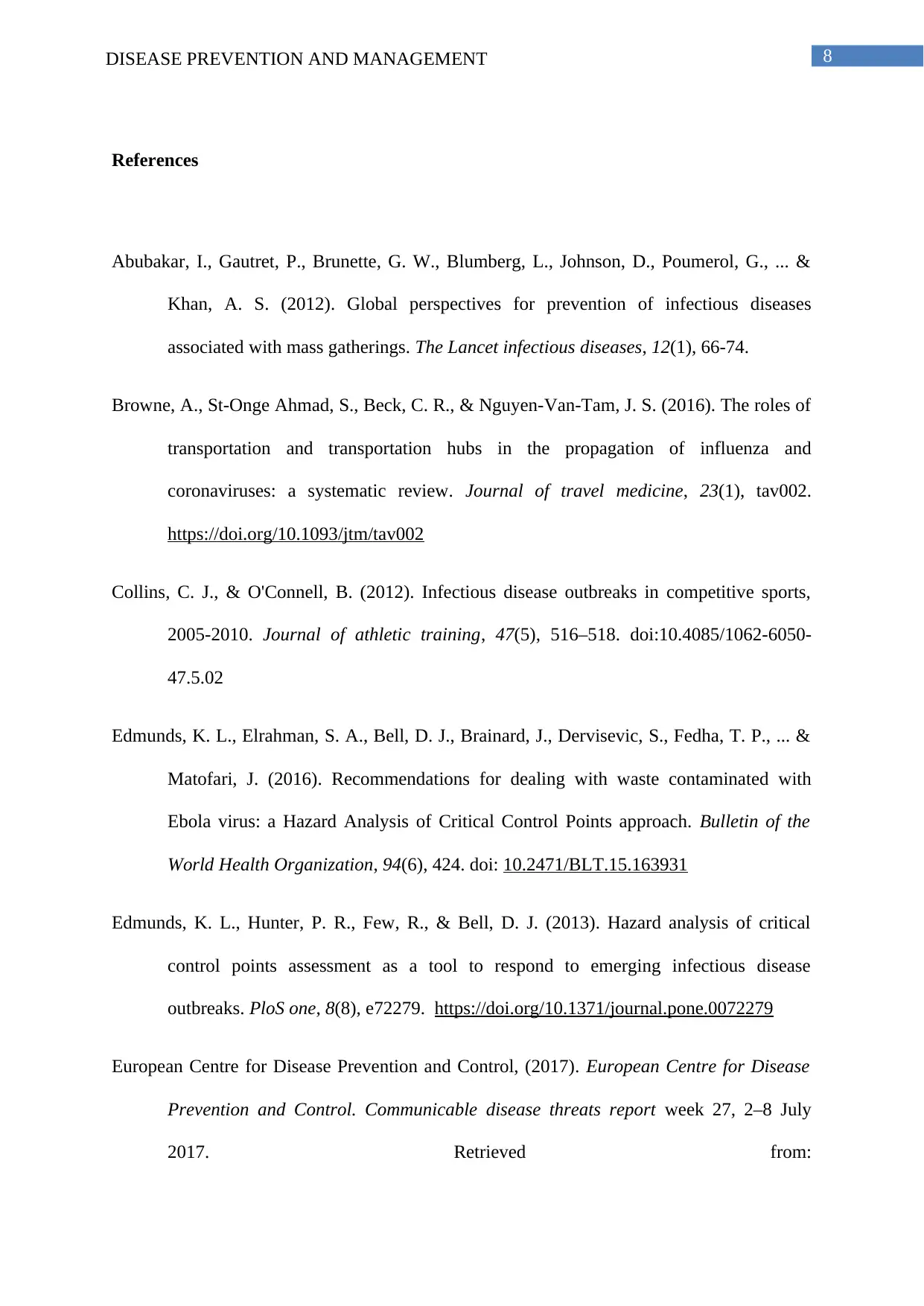
8DISEASE PREVENTION AND MANAGEMENT
References
Abubakar, I., Gautret, P., Brunette, G. W., Blumberg, L., Johnson, D., Poumerol, G., ... &
Khan, A. S. (2012). Global perspectives for prevention of infectious diseases
associated with mass gatherings. The Lancet infectious diseases, 12(1), 66-74.
Browne, A., St-Onge Ahmad, S., Beck, C. R., & Nguyen-Van-Tam, J. S. (2016). The roles of
transportation and transportation hubs in the propagation of influenza and
coronaviruses: a systematic review. Journal of travel medicine, 23(1), tav002.
https://doi.org/10.1093/jtm/tav002
Collins, C. J., & O'Connell, B. (2012). Infectious disease outbreaks in competitive sports,
2005-2010. Journal of athletic training, 47(5), 516–518. doi:10.4085/1062-6050-
47.5.02
Edmunds, K. L., Elrahman, S. A., Bell, D. J., Brainard, J., Dervisevic, S., Fedha, T. P., ... &
Matofari, J. (2016). Recommendations for dealing with waste contaminated with
Ebola virus: a Hazard Analysis of Critical Control Points approach. Bulletin of the
World Health Organization, 94(6), 424. doi: 10.2471/BLT.15.163931
Edmunds, K. L., Hunter, P. R., Few, R., & Bell, D. J. (2013). Hazard analysis of critical
control points assessment as a tool to respond to emerging infectious disease
outbreaks. PloS one, 8(8), e72279. https://doi.org/10.1371/journal.pone.0072279
European Centre for Disease Prevention and Control, (2017). European Centre for Disease
Prevention and Control. Communicable disease threats report week 27, 2–8 July
2017. Retrieved from:
References
Abubakar, I., Gautret, P., Brunette, G. W., Blumberg, L., Johnson, D., Poumerol, G., ... &
Khan, A. S. (2012). Global perspectives for prevention of infectious diseases
associated with mass gatherings. The Lancet infectious diseases, 12(1), 66-74.
Browne, A., St-Onge Ahmad, S., Beck, C. R., & Nguyen-Van-Tam, J. S. (2016). The roles of
transportation and transportation hubs in the propagation of influenza and
coronaviruses: a systematic review. Journal of travel medicine, 23(1), tav002.
https://doi.org/10.1093/jtm/tav002
Collins, C. J., & O'Connell, B. (2012). Infectious disease outbreaks in competitive sports,
2005-2010. Journal of athletic training, 47(5), 516–518. doi:10.4085/1062-6050-
47.5.02
Edmunds, K. L., Elrahman, S. A., Bell, D. J., Brainard, J., Dervisevic, S., Fedha, T. P., ... &
Matofari, J. (2016). Recommendations for dealing with waste contaminated with
Ebola virus: a Hazard Analysis of Critical Control Points approach. Bulletin of the
World Health Organization, 94(6), 424. doi: 10.2471/BLT.15.163931
Edmunds, K. L., Hunter, P. R., Few, R., & Bell, D. J. (2013). Hazard analysis of critical
control points assessment as a tool to respond to emerging infectious disease
outbreaks. PloS one, 8(8), e72279. https://doi.org/10.1371/journal.pone.0072279
European Centre for Disease Prevention and Control, (2017). European Centre for Disease
Prevention and Control. Communicable disease threats report week 27, 2–8 July
2017. Retrieved from:
⊘ This is a preview!⊘
Do you want full access?
Subscribe today to unlock all pages.

Trusted by 1+ million students worldwide
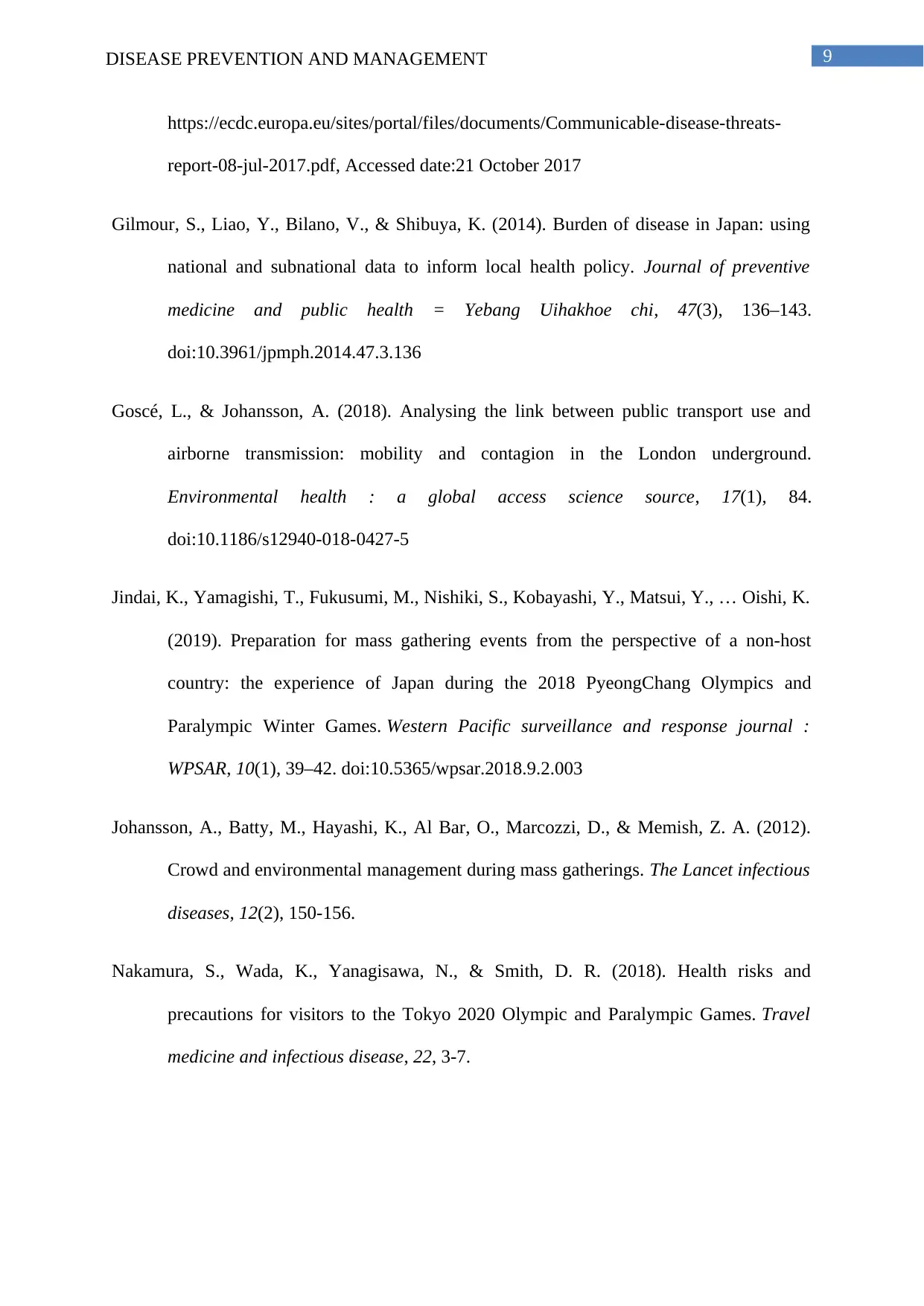
9DISEASE PREVENTION AND MANAGEMENT
https://ecdc.europa.eu/sites/portal/files/documents/Communicable-disease-threats-
report-08-jul-2017.pdf, Accessed date:21 October 2017
Gilmour, S., Liao, Y., Bilano, V., & Shibuya, K. (2014). Burden of disease in Japan: using
national and subnational data to inform local health policy. Journal of preventive
medicine and public health = Yebang Uihakhoe chi, 47(3), 136–143.
doi:10.3961/jpmph.2014.47.3.136
Goscé, L., & Johansson, A. (2018). Analysing the link between public transport use and
airborne transmission: mobility and contagion in the London underground.
Environmental health : a global access science source, 17(1), 84.
doi:10.1186/s12940-018-0427-5
Jindai, K., Yamagishi, T., Fukusumi, M., Nishiki, S., Kobayashi, Y., Matsui, Y., … Oishi, K.
(2019). Preparation for mass gathering events from the perspective of a non-host
country: the experience of Japan during the 2018 PyeongChang Olympics and
Paralympic Winter Games. Western Pacific surveillance and response journal :
WPSAR, 10(1), 39–42. doi:10.5365/wpsar.2018.9.2.003
Johansson, A., Batty, M., Hayashi, K., Al Bar, O., Marcozzi, D., & Memish, Z. A. (2012).
Crowd and environmental management during mass gatherings. The Lancet infectious
diseases, 12(2), 150-156.
Nakamura, S., Wada, K., Yanagisawa, N., & Smith, D. R. (2018). Health risks and
precautions for visitors to the Tokyo 2020 Olympic and Paralympic Games. Travel
medicine and infectious disease, 22, 3-7.
https://ecdc.europa.eu/sites/portal/files/documents/Communicable-disease-threats-
report-08-jul-2017.pdf, Accessed date:21 October 2017
Gilmour, S., Liao, Y., Bilano, V., & Shibuya, K. (2014). Burden of disease in Japan: using
national and subnational data to inform local health policy. Journal of preventive
medicine and public health = Yebang Uihakhoe chi, 47(3), 136–143.
doi:10.3961/jpmph.2014.47.3.136
Goscé, L., & Johansson, A. (2018). Analysing the link between public transport use and
airborne transmission: mobility and contagion in the London underground.
Environmental health : a global access science source, 17(1), 84.
doi:10.1186/s12940-018-0427-5
Jindai, K., Yamagishi, T., Fukusumi, M., Nishiki, S., Kobayashi, Y., Matsui, Y., … Oishi, K.
(2019). Preparation for mass gathering events from the perspective of a non-host
country: the experience of Japan during the 2018 PyeongChang Olympics and
Paralympic Winter Games. Western Pacific surveillance and response journal :
WPSAR, 10(1), 39–42. doi:10.5365/wpsar.2018.9.2.003
Johansson, A., Batty, M., Hayashi, K., Al Bar, O., Marcozzi, D., & Memish, Z. A. (2012).
Crowd and environmental management during mass gatherings. The Lancet infectious
diseases, 12(2), 150-156.
Nakamura, S., Wada, K., Yanagisawa, N., & Smith, D. R. (2018). Health risks and
precautions for visitors to the Tokyo 2020 Olympic and Paralympic Games. Travel
medicine and infectious disease, 22, 3-7.
Paraphrase This Document
Need a fresh take? Get an instant paraphrase of this document with our AI Paraphraser
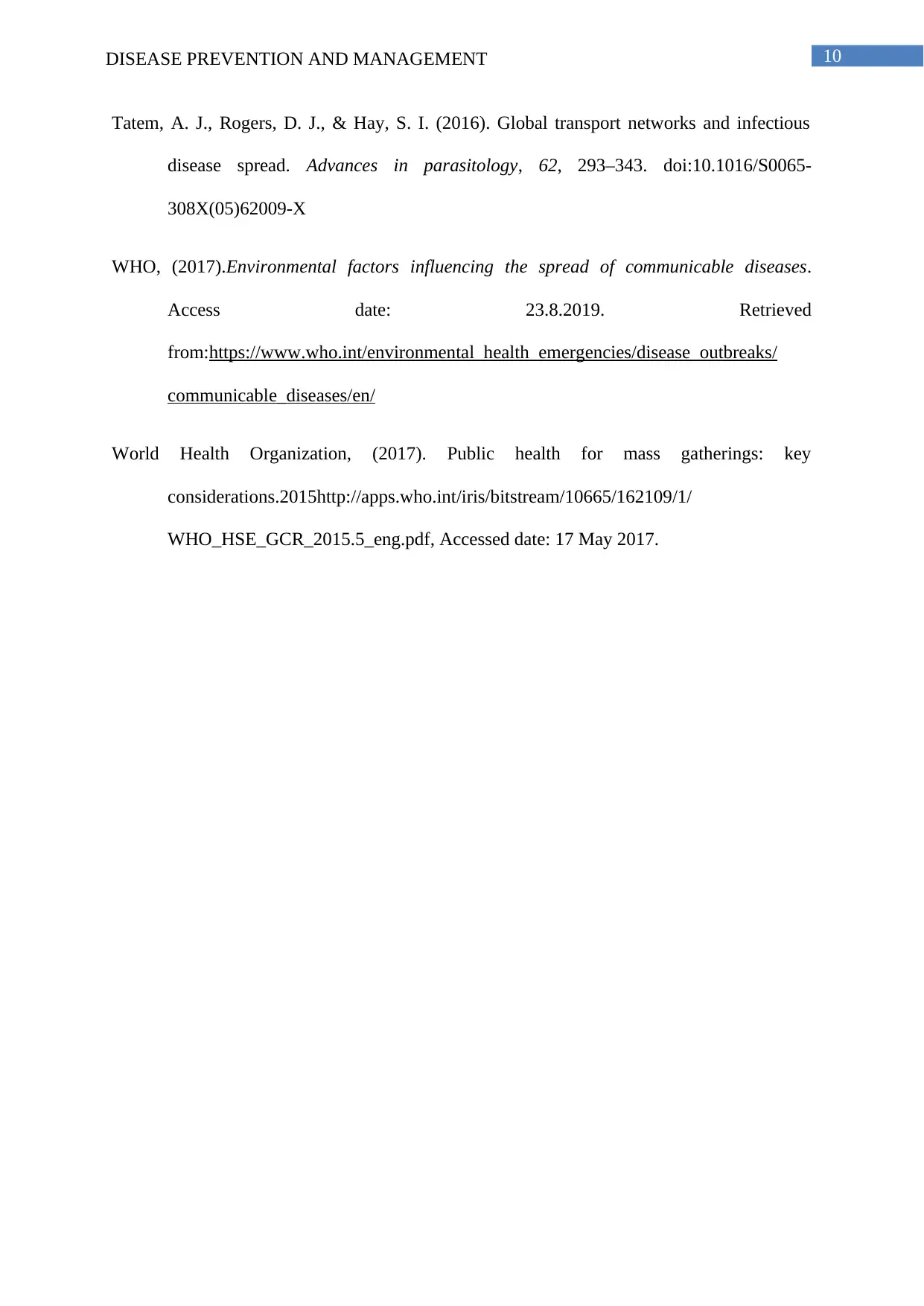
10DISEASE PREVENTION AND MANAGEMENT
Tatem, A. J., Rogers, D. J., & Hay, S. I. (2016). Global transport networks and infectious
disease spread. Advances in parasitology, 62, 293–343. doi:10.1016/S0065-
308X(05)62009-X
WHO, (2017).Environmental factors influencing the spread of communicable diseases.
Access date: 23.8.2019. Retrieved
from:https://www.who.int/environmental_health_emergencies/disease_outbreaks/
communicable_diseases/en/
World Health Organization, (2017). Public health for mass gatherings: key
considerations.2015http://apps.who.int/iris/bitstream/10665/162109/1/
WHO_HSE_GCR_2015.5_eng.pdf, Accessed date: 17 May 2017.
Tatem, A. J., Rogers, D. J., & Hay, S. I. (2016). Global transport networks and infectious
disease spread. Advances in parasitology, 62, 293–343. doi:10.1016/S0065-
308X(05)62009-X
WHO, (2017).Environmental factors influencing the spread of communicable diseases.
Access date: 23.8.2019. Retrieved
from:https://www.who.int/environmental_health_emergencies/disease_outbreaks/
communicable_diseases/en/
World Health Organization, (2017). Public health for mass gatherings: key
considerations.2015http://apps.who.int/iris/bitstream/10665/162109/1/
WHO_HSE_GCR_2015.5_eng.pdf, Accessed date: 17 May 2017.
1 out of 11
Related Documents
Your All-in-One AI-Powered Toolkit for Academic Success.
+13062052269
info@desklib.com
Available 24*7 on WhatsApp / Email
![[object Object]](/_next/static/media/star-bottom.7253800d.svg)
Unlock your academic potential
Copyright © 2020–2025 A2Z Services. All Rights Reserved. Developed and managed by ZUCOL.





